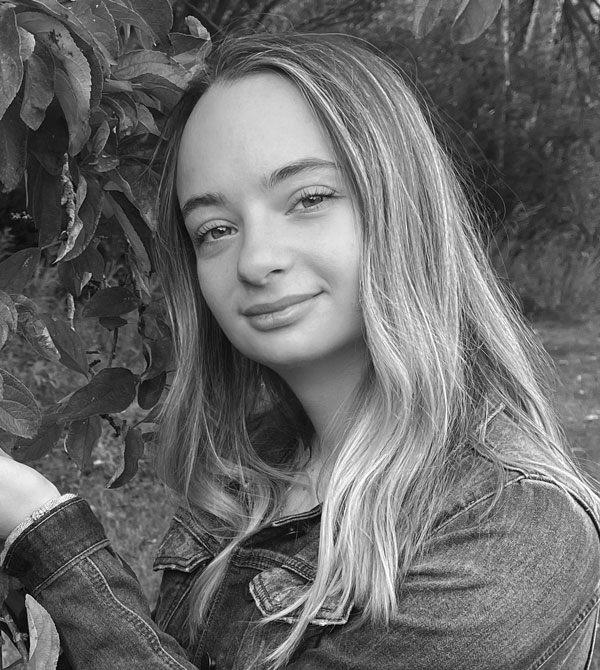

AP Drawing
Veronika
Popova
Hoover High School|North Canton, Ohio

Dimensions: 19”x 22”|Material(s): Acrylic paint, watercolor paint, colored pencil, glue|Process(es): Process of applying light acrylic paint on the base, next to thick paint, and then colored pencils as final.|Curatorial Note: The immigration game is a successful visual illustration narrative speaking to the mental and physical experiences. Color, shape, line, and texture are explored in this artwork.
Student statement
Student statement
Immigration is when people experience themselves in a different place, understanding that there is a new adventure and life ahead. Immigrants move out of their homelands and embark on a journey to their final destination, which is packed with challenges, phases, and discoveries. The "Game of Immigration" is one of my favorite artworks and the largest in my portfolio. The game pieces tell a short visual story of every immigrant, representing diverse countries and cultures, who encounter different paths in many parts of the world. In a deeper context, the word 'game' also means 'challenge.' In my artwork, the player or a participant experiences challenges to reach a specific bonus or goal.
The elements and accessories of a typical board game take physical and emotional factors that can affect the player's movements. In the "Game of Immigration," the immigrants’ journey is marked with dots on paths and uses specific colors and cards. Their journey is also dependent on the players above them. The allusion of a board game creates unexpected and exciting challenges that immigrants, as participants of this experience, may encounter on their journey.
Sustained Investigation, Materials: Colored Pencil|Process(es): Figurines of immigrants are drawn with colored pencils, cut out and applied to the previous SI.
How can I illustrate the physical and mental circumstances that immigrants face? My investigation explores immigrants who arrive from different countries to experience a new life in a new country.
Teacher statement
Teacher statement
Chris Triner
How did you scaffold writing into the artmaking and thinking process?
AP Art and Design students are accustomed to writing responses and documenting their thinking from their first art class here at Hoover High School. Students are expected to 'propose' at least two concept sketches for most units of study. In these proposals, they are asked to defend their reasoning as to why one of the works is stronger. They are encouraged to use appropriate vocabulary and design elements/principles in their defense. As they progress, they are expected to continue this practice. It is an organic part of AP programming before students begin the course.
To put a finer point on the writing in AP Art and Design, we expect students to write to each of the tenets of the AP rubric (process, materials, revision, etc.).
How did you structure, practice, experimentation, and revision into your AP Art and Design curriculum?
In earlier courses, our students learn the artistic process (inspiration, proposing/planning, reflecting on results, and gaining peer feedback). This practice allows them to have organic and natural peer conversations. They learn to document these conversations, and we add the expectation of goal-setting by asking students to set three action steps needed to complete their in-studio work successfully. A mid-critique or 'mid-crit' is foundational as a formative review of their work by me and their peers. Artworks must be 50% complete for all mid-crits so there is time for a fair review of each student's work.
What formative and summative assessments helped guide your students through your AP Art & Design Curriculum?
Formative mid-crits and my circulation intervals around each student’s independent workspace allow for direct feedback and discussion without distraction. At summative assessments, students must complete a digital slide presentation that displays the following:
* a working sustained investigation statement,
* a slide with one to three photos documenting research and process,
* one slide with multiple images of the progression of work,
* and a final slide with the completed sustained investigation.
This requirement creates a complete record of student work for reference in the submission process and has been instrumental in keeping me and the students accountable. Once their slides are submitted, I provide video feedback on their work and the AP Art and Design rubric to connect the learning goals.
What creative programming (i.e., exhibit spaces, mentoring programs, curricular supports) have you implemented to support AP Art and Design students?
I collaborate with an English teacher at my school, and I have her come into my classroom one day a year to have students share their working sustained investigation statements. She discusses with students the tenets of a good thesis statement and the power of a descriptive phrase. She offers such helpful insight that I could never provide.
Fortunately, a working student-powered art gallery is steps away from the AP Art and Design space. In our gallery, student curators organize, promote, and display a minimum of four shows a school year. The finale show, planned throughout the year, showcases AP work open to our school and community. This display directly relates to the students' AP Art and Design portfolio work. They see this display of work as a way to share their artistic voice and consider how their intended message will be conveyed to an audience. They work hard to have their sustained investigation statements and a selection of their portfolio on display.
What did you learn from working with your student?
Veronika has taught me to reflect more about each student’s background and how this directly impacts their connections to learning. In Veronika’s case, her life traveling and transitioning to becoming a citizen of the United States as a small child greatly impacted her personal voice and her connection to the content she was creating. I had to have time to dialogue with her to think about how she could explain her experiences and fully explain the immigration process. As classroom teachers, time is precious when working with individual students, and finding moments to conference with Veronika while attending to other students was challenging but essential to her process.
What is your advice to other AP Art and Design teachers?
First, surround yourself with other great art teachers in your school community who support you and your student’s learning. We are so fortunate to have an amazing group of committed art educators who work in unison to support the entire child. I don’t have all the answers, and I want our students to refer to their other art experiences to strengthen their responses in AP Art and Design.
Be intentional in your own art making, whatever that might look like, and how it relates to the AP Art and Design assessments. As I create, I have thought a lot about how I feel in the process and have documented my thinking. I consider how natural or easy it might not be for some students. I’ve had to become less rigid and structured in my expectations on how I formatively assess students’ growth. Each student’s growth is not timed, easily measured, or set to a schedule. I always tell students that at some point, they will find their 'why' or 'ah-ha' moment. It might not be in September, which can be frustrating for them (and me), but as soon as it happens, we celebrate it, and I encourage them to act upon it quickly.
Veronika Popova



